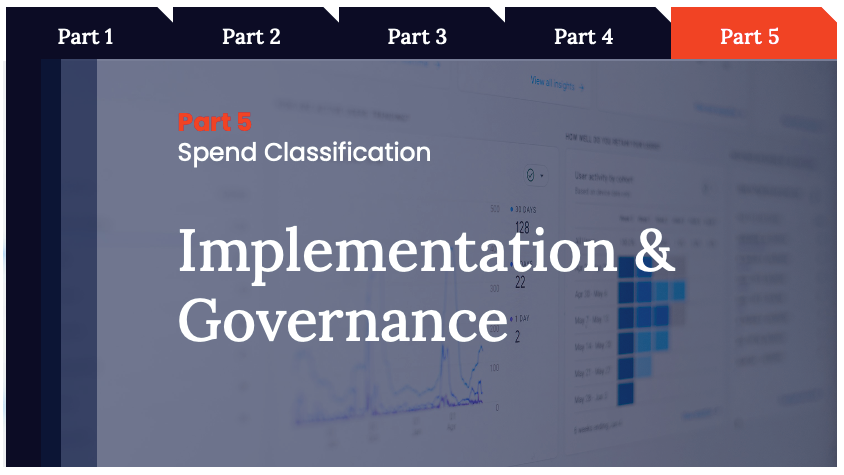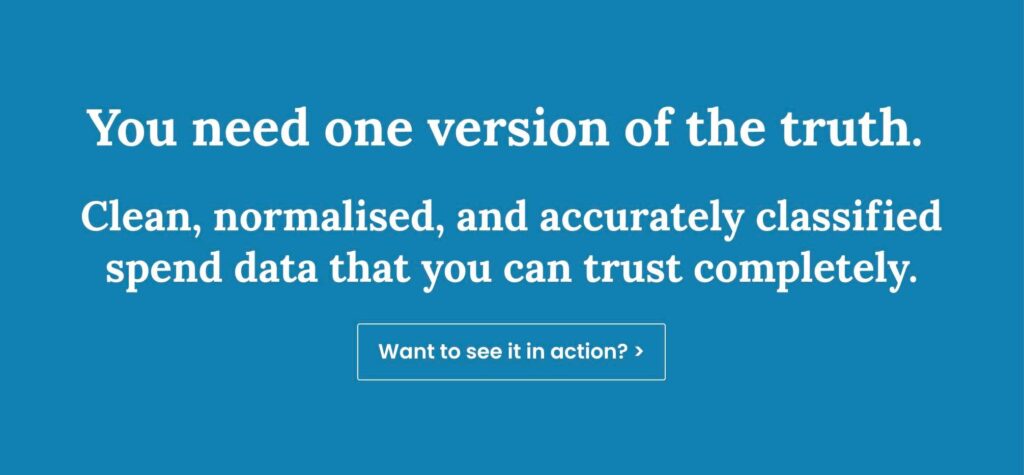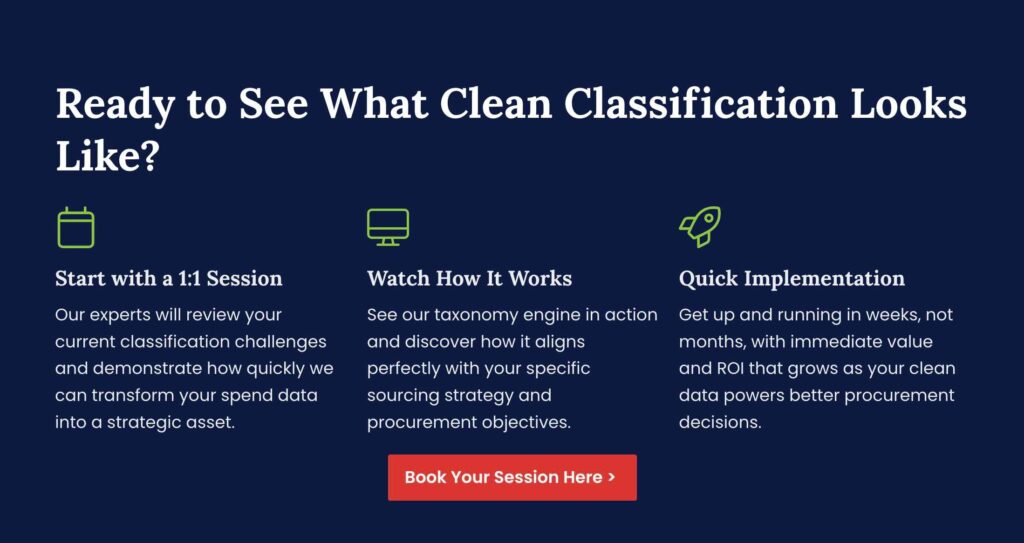
Spend Classification Series . 5-part guide
Previous: Human + Machine for Scale & Accuracy (Part 4)
Welcome back to our 5 part series on procurement spend classification.
Twelve months after a glittering go-live, the spend-analysis dashboard told an ugly story: the ‘Other’ bucket had doubled, duplicate suppliers were back, and auditors complained that half the categories looked nothing like the agreed taxonomy.
Sound familiar?
It’s the fate of many programmes that stop at data-cleansing, taxonomy design, and fancy AI models.
If you’ve followed Parts 1-4, you already have crystal-clear data, a three-level taxonomy everyone understands, and an AI engine classifying 95 percent of transactions on autopilot. Part 5 shows how to keep all that good work alive.
We’ll map a nine-step rollout, define lightweight governance that won’t strangle the team, and reveal the KPIs that spot drift before “Miscellaneous” balloons again.
The difference between a successful rollout and expensive failure? It’s not the technology, it’s the discipline that comes after.
This is the turning point where many procurement programs stall, stuck in a cycle of rework and erosion. But with the right rollout, governance, and refresh rhythm, your classification engine can stay sharp, strategic, and self-sustaining.
The 9-Step Roadmap to Bulletproof Spend Classification
A Proven Implementation Framework for AI-Driven Procurement Taxonomy and Data Governance
A successful roll-out follows a predictable arc, beginning with vision and ending in self-sustaining refresh cycles.
1. Clarify spend analysis objectives and win sponsorship.
Before a single line of data moves, define success with precision.
This means setting measurable, outcome-focused goals like “classify 95% of indirect spend within 60 days,” “surface 7% actionable savings opportunities,” or “cut ‘Miscellaneous’ to under 3%” rather than vague aspirations like “improve visibility.” Where possible, tie these objectives to wider procurement imperatives such as ESG reporting, supplier diversity, contract compliance, or inflation mitigation.
Next, secure not just a sponsor, but a champion.
You need an executive with budget control and enough political capital to remove roadblocks fast. A passive approver may sign your business case, but an active champion will attend key governance milestones, escalate integration delays or resourcing gaps, publicly back the initiative at leadership forums, and push adoption in their own business unit.
To anchor both direction and accountability, create a one-page “success charter.”
This document should cover your strategic objectives and how they support wider procurement KPIs, baseline metrics and target outcomes, key stakeholders and their roles, high-level timeline and budget envelope, plus explicit non-goals such as “This phase will not cover direct materials or travel spend.”
Review and sign off this charter with your champion, then circulate it to all project stakeholders. A clear and visible north star protects the project from scope creep and builds confidence across the organization.
2. Freeze the Taxonomy (But Plan for Change)
With the three-level MECE taxonomy built in Part 3, it’s time to lock it down formally.
This is not just a structural asset, but the backbone of your entire classification engine, spend cube, and dashboard layer. Finalise category names, publish plain-language definitions for every node, and gain explicit sign-off from key stakeholders across procurement, finance, and business units. This eliminates ambiguity, prevents late-stage relabelling, and protects downstream logic from classification rules to BI dashboards.
But don’t confuse freezing with rigidity.
Introduce a lightweight change control process so that legitimate business needs such as a new regulatory requirement or an emerging category can be accommodated without chaos.
A good process includes a structured change request template with business justification, impact assessment, and timeline. You’ll also need defined review gates, whether monthly or quarterly depending on your stability needs, plus a core taxonomy governance group comprising category leads, data stewards, and systems owners to approve or defer changes. Clear version control helps you track changes over time and maintain lineage for audit and training purposes.
If your taxonomy spans multiple business units, geographies, or languages, design with localisation in mind. This doesn’t mean duplicating taxonomies by country. Instead, enable region-specific aliases or labels in local languages, mapping tables that translate global categories into local GL/accounting terminology, and guidance on interpreting categories with culturally or operationally specific nuances.
“Flexibility without structure is chaos. Structure without flexibility is death.”
Done well, freezing the taxonomy is not a straitjacket but the anchor point for scalable, auditable classification. With smart governance in place, you gain the stability of a common structure and the flexibility to evolve as your business does.
3. Map the Procurement Data Landscape (And Audit for Quality)
Before any data can be classified, you need to know where it lives and whether it can be trusted.
Start by creating a comprehensive inventory of all source systems that capture spend data. This includes obvious systems like ERPs and P-card platforms, as well as less structured sources like travel booking tools, expense apps, tail-spend spreadsheets, and invoice-scanning archives. Don’t forget shadow systems in business units or shared services centers that often hold critical but overlooked data.
Your goal is to cover at least 95% of total spend volume not just in value, but in transactional diversity. Classifying $10 million across 100,000 P-card swipes is not the same as 10 SAP purchase orders.
You can’t manage what you can’t see. You can’t trust what you haven’t tested.
Once you’ve mapped your systems, tag each one with a named data owner. This ensures accountability for access, field definitions, and long-term governance. If data gets delayed or schema changes, you know who to call. You’ll also need to document data structures and extraction methods such as APIs, flat files, or manual exports, along with update frequency, volume, and key fields.
But don’t stop at existence. Run a baseline data quality audit on each source. Check for missing or inconsistent PO numbers, blank or misused cost centers, vendor name mismatches like “Acme Ltd” versus “ACME LIMITED,” currency mismatches, and overloaded description fields where “Miscellaneous” becomes the default.
Grade each source system on completeness, consistency, and reliability. This will influence ETL design and help you triage cleansing effort later.
A well-mapped, well-audited data landscape sets the foundation for trustworthy classification and governance. Skip this, and you’ll spend the next 12 months chasing down blind spots in your cube.
4. Build ETL Pipelines and Cleanse (Then Plan for Hygiene)
Now that you know where your data lives and how clean it is, it’s time to automate the flow. This step separates tactical pilots from scalable platforms.
Start by building Extract-Transform-Load (ETL) pipelines for each source system. Where possible, automate data feeds to run on a scheduled cadence such as weekly or monthly. Apply consistent transformations including currency conversion to a common base, date standardisation, unit harmonisation like litres versus gallons, and supplier name normalisation to resolve variations like Acme Inc. versus ACME LTD.
Define a common schema that every record must conform to before it enters the classification engine. This includes fields like amount, date, supplier, business unit, GL code, and free-text description. This schema acts as the contract between upstream systems and downstream analytics.
Split this step into two clear phases:
1. Initial Cleanse
This is your once-off, heavy-lift effort to deduplicate vendors using fuzzy matching and master data lookups, resolve blank or defaulted fields like “Unknown” cost centers, detect and patch inconsistent tax treatments or FX handling, and flatten multiple hierarchies into one harmonised view.
Run test batches through a dedicated staging environment before they hit your production environment. This lets you catch load failures or schema mismatches early, validate transformations against known benchmarks, and experiment with rule tuning without polluting live dashboards.
2. Ongoing Hygiene
The real risk isn’t dirty data on day one but drift. Every ETL setup needs built-in hygiene checks including field-level validation rules like “supplier name must not be blank,” automated alerts when a source feed fails or schema changes, and anomaly flags for unexpected volume spikes, missing records, or currency errors.
Appoint a data steward or team responsible for monitoring these metrics and triaging exceptions.
When duplicate vendors drop to near-zero, every file lands without manual effort, and data refreshes happen like clockwork, you’ve laid the foundation. But without hygiene discipline, even the cleanest pipeline turns to sludge in under a year.
Clean data is table stakes. Staying clean is where the real work begins.

5. Run the First Auto-Classification Pass (Rules, ML, and the Gray Areas Between)
With clean, harmonised data flowing in, you’re ready to load the engine. This is where the magic happens: raw spend is transformed into classified insights at scale.
Feed your cleansed spend cube into a hybrid classification engine that blends deterministic rules with probabilistic machine learning models. Each has a distinct role to play.
Deterministic Rules
Hard-coded logic like “if supplier name = Staples, then category = Office Supplies” is fast, auditable, and ideal for known, stable vendors, simple mappings such as fixed GL codes, and regulatory or compliance-driven categories where explainability is critical.
These rules are precise but brittle. They break easily when supplier naming conventions change or product bundling increases.
Supervised ML Models
Machine learning shines where deterministic rules fall short, especially with free-text descriptions that have inconsistent phrasing, category inference from multiple data fields like supplier plus line item plus cost center, and emerging or ambiguous transactions without historic rule coverage.
ML learns from tagged history and patterns, then assigns likely categories to new transactions. But ML models operate on confidence scores, not certainties. That’s why the first classification pass should include a confidence threshold, typically set to auto-tag around 80% of lines where the model is highly certain.
This frees up analysts to focus on the gray areas: the 20% of spend that tends to be ambiguous like “IT Services” versus “Consulting” versus “Software Support,” bundled such as “Monthly Facilities Invoice” covering cleaning, HVAC, and pest control, unfamiliar including new vendors or SKUs not seen in training data, or high-risk or high-value transactions which may require double-checking regardless of model confidence.
Log both the classification outcome and the confidence score for every line. These will guide review workflows in Step 6 and help refine thresholds over time.
Don’t aim for perfection in this first pass.
Aim for a strong, explainable baseline that puts your analysts in the loop, not in the weeds.
The goal isn’t to replace human judgment. It’s to amplify it.
No matter how advanced your classification engine is, some portion of spend will always require human eyes, especially in the early stages. Step 6 is where human intelligence completes what artificial intelligence began.
Set up a review queue of transactions that fall below the model’s confidence threshold or exceed predefined risk triggers such as high-value lines, new suppliers, or certain sensitive categories. But don’t send all these to a generic analyst pool. Define who reviews what, based on both expertise and risk profile.
- Finance reviews tail spend, GL-account inconsistencies, and anything with compliance implications.
- Procurement owns core category accuracy, especially for strategic or managed spend.
- Legal or Risk audits services-related spend, especially in categories with contract dependencies like legal and consulting.
- Shared Services or BPOs may triage routine or transactional errors, based on rules.
This division of review labor prevents bottlenecks and raises confidence in the resulting classifications.
Every manual correction feeds two purposes:
it reclassifies the current transaction for reporting and trains the model for future accuracy.
But beware of annotation bias where different reviewers may interpret the same transaction differently. To manage this, create category-specific guidance that clarifies edge cases and provides tagging examples.
Monitor for inter-annotator disagreement rates, and if two reviewers diverge on the same item, flag it for adjudication. Designate a taxonomy steward or dispute arbiter to resolve contested cases and update guidance accordingly.
Once the loop runs consistently and overall classification accuracy passes your predefined threshold such as 95%, lock the model version. This provides a stable foundation for reporting and audit, while also allowing you to benchmark drift in future refresh cycles.
The goal here isn’t to eliminate humans from the process but to deploy them where they matter most, and to continuously elevate both machine and team performance.
6. Launch the Procurement Dashboards (And Train Users to Ask Smarter Questions)
Once classified spend data is flowing reliably, it’s time to unleash its value.
Pipe the enriched, taxonomy-aligned data into your BI layer making the dashboards intuitive, self-service, and aligned to the workflows of procurement, finance, and business stakeholders.
But don’t assume “build it and they will come.”
Dashboard adoption is a change-management exercise.
Start with a structured training plan. Host live walk-throughs for each function like procurement, finance, legal, and operations, tailored to their roles and use cases. Record short “how-to” videos and cheat sheets covering key tasks like filtering by supplier, drilling into line-level data, or exporting views. Offer hands-on sessions with sample scenarios such as “find duplicate vendors in professional services” or “spot contract leakage in marketing spend.”
Nominate power users or dashboard champions within each department.
These people will act as first-line support, escalate bugs or data questions, and help translate business needs into analytical insights.
When well executed, these dashboards shift the internal dialogue from “Where is the data?” to more strategic, outcome-oriented questions. Teams start asking “Why are we paying three different rates for the same software license?” or “Can we consolidate these five suppliers into one master agreement?”
They dig into questions like “Why is legal spend up 18% in Q2 and was it driven by new matters or rate increases?” They examine whether training costs are being allocated consistently across business units and which cost centers are trending out of budget, plus which vendors are driving those variances.
To ensure sustained value, embed these dashboards in monthly category reviews, quarterly business reviews, and annual budgeting cycles. Don’t let them sit in the corner as a reporting tool. Make them part of the way decisions get made.
Dashboards are the lens through which all your upstream work becomes visible. Done right, they move spend analysis from reactive clean-up to proactive insight.
7. Hand Over Spend Classification Governance
The technical rollout may be complete, but the real success lies in operationalising your classification engine by turning a project into a sustainable business process.
That requires clear ownership, defined responsibilities, and lightweight, resilient governance.
Start by establishing a RACI matrix that covers three key domains.
- Taxonomy Ownership typically sits with a senior procurement operations lead or taxonomy steward who approves category changes, resolves classification disputes, and runs quarterly reviews. They’re supported by category managers and data analysts.
- Classification Engine Ownership belongs to a data science or analytics lead, or a third-party provider if outsourced. Their responsibilities include maintaining ML models, adjusting confidence thresholds, triggering re-training cycles, and monitoring model health. Data engineers and procurement analysts provide support.
- Dashboard and Reporting Ownership usually falls to a BI/reporting lead or finance business partner who maintains dashboard accuracy, manages data refreshes, and gathers user feedback. Power users and business stakeholders provide ongoing support.
When everyone owns everything, no one owns anything.
Each of these roles should be tied to a cadence of activity. Monthly tasks include data refreshes, unclassified percentage monitoring, and user feedback intake. Quarterly activities cover taxonomy review, rule updates, and model performance check-ins. Annual responsibilities encompass model re-training, KPI benchmarking, and stakeholder surveys.
To avoid governance becoming a bureaucratic black hole, use lightweight tooling. A shared wiki or Confluence space houses taxonomy definitions, model documentation, and process guides. A Jira or Trello board manages change requests, model tuning, and enhancement tickets. A dedicated Slack or Teams channel handles day-to-day triage, collaboration, and knowledge-sharing between data, procurement, and finance teams.
Also, consider publishing a “classification scorecard” each month showing key health metrics including percentage of spend classified, percentage in “Other,” model confidence trends, manual review backlog, and taxonomy change volume.
8. Commit to Continuous Refresh
A procurement classification engine isn’t a set-it-and-forget-it tool but a living system, shaped by evolving spend patterns, supplier changes, and new business needs.
Even with robust governance, drift is inevitable.
The goal is to spot it early, react quickly, and refresh intelligently without overwhelming your team.
Start by defining a core set of drift indicators. Monitor your unclassified percentage to see if more lines are falling outside your confidence threshold. Track “Other” bucket growth to identify transactions becoming increasingly uncategorizable within the current taxonomy. Watch model confidence trends to spot declining average confidence scores over time. Pay attention to taxonomy mismatch flags where users or auditors are flagging misaligned categories more frequently.
To stay ahead of trouble, embed these indicators directly into your dashboards. Build a “Classification Health” panel with traffic-light thresholds such as green under 3%, yellow at 5%, red above 8% unclassified. Configure auto-alerts when any KPI breaches defined limits and send notifications to taxonomy owners, analysts, or a Slack channel for immediate triage.
When drift indicators breach your thresholds like a 2-3 point movement in unclassified spend, trigger a controlled refresh cycle. A standard re-train cycle typically takes 3-4 weeks and can run in parallel with business-as-usual classification.
Example Model Re-Train Cycle
- Week one begins with trigger and scope, where the taxonomy or analytics lead confirms the need for re-training based on dashboard alerts and defines scope such as services categories only or the last 6 months of data. The team then extracts a new training set including recent low-confidence and misclassified lines, while analysts reclassify 5,000-10,000 records with human-confirmed labels.
- Week two focuses on model training and testing. The data science team retrains the model using updated annotations and runs A/B tests against the current model to validate performance improvement.
- Week three involves stakeholder review and approval. The team shares key metrics including precision, recall, confidence shifts, and edge case handling, while the taxonomy owner or data governance group signs off on deployment.
- Week four covers deployment and monitoring. The new model goes live and the team monitors KPIs closely for the next 2-3 refreshes.
Pro tip: Use version control for your model and training data, just like software. This helps diagnose regressions and explain changes to auditors or executives.
Done well, this refresh cycle becomes routine: a quiet, efficient process that keeps your engine accurate while your procurement team focuses on strategy, negotiation, and insight, not data janitorial work.
Your goal isn’t just to maintain accuracy but to keep the system aligned with reality. That’s how your spend classification engine stays sharp, relevant, and trusted.
The best governance is the kind you don’t notice-until it saves you.
But automation isn’t enough on its own. Without clear ownership and a cadence to keep it tuned, even the best classification engine will drift. That’s where smart, lightweight governance comes in.

Governance That Works-Without the Red Tape
How to Build a Lightweight, Scalable Procurement Spend Classification Governance Model
Classification success lives or dies on disciplined after-care, but that doesn’t mean layers of bureaucracy. The goal is just enough structure to stay accurate, auditable, and responsive as spend evolves.
Start by anchoring governance in a multi-owner model, not a single gatekeeper.
Assign clear leads for each domain.
- The Taxonomy Owner approves structure changes, resolves category disputes, and runs quarterly taxonomy reviews.
- The Classification Engine Owner monitors drift, manages re-training cycles, and tunes rules or thresholds.
- The BI/Reporting Owner ensures dashboards reflect the latest data, supports end users, and resolves reporting anomalies.
Together, they form the core governance triad, supported by a small circle of category and business reps who flag edge cases, voice market shifts, and advocate for users.
Run governance on a two-speed cadence.
- Monthly micro-updates handle cleansing new supplier aliases, adjusting rules where confidence has dropped, and monitoring load health.
- Quarterly deep-dives review taxonomy relevance, prune obsolete branches, assess training data quality, and re-train the ML model if needed.
To keep everything transparent, manage your artifacts in lightweight, collaborative tooling.
Use a shared wiki or Confluence space for taxonomy definitions, classification guidance, and review logs. Set up a Jira or Trello board to track rule updates, taxonomy change requests, and re-training cycles. Create a Slack or Teams channel for quick questions, alerts, and cross-functional triage.
All assets including taxonomy versions, mapping tables, and rule dictionaries should be version-controlled. When someone proposes a change, they submit a change ticket or pull request, not an email buried in someone’s inbox.
Finally, embed drift detection directly into your dashboard ecosystem with a traffic-light scorecard.
Monitor unclassified spend percentage with yellow at 5% and red above 8%. Track model accuracy versus gold-standard sample where degradation by 2 points triggers recalibration. Watch growth of the “Other” bucket where spikes over 10% month-on-month trigger taxonomy review.
These thresholds aren’t one-size-fits-all, so adjust based on your risk tolerance and spend complexity. But don’t wait for auditors to flag problems. Green means business as usual. Amber prompts scheduled action. Red escalates to your steering group before the executive asks why “IT Services” is back under “Miscellaneous.”
Governance shouldn’t be a chore. Done right, it becomes a rhythm: quiet, predictable, and invaluable.
Still, even the best-governed systems are vulnerable to slow erosion. To stay ahead, it’s critical to watch for the subtle warning signs that your classification engine is starting to slip.
Top 4 Risks That Derail Spend Taxonomy Programs After Go-Live
Even with clean data, a well-trained model, and a governance cadence in place, classification systems can quietly decay. These are the four most common failure patterns that creep in after implementation and how to catch them before they cause real damage.
Set-and-Forget Syndrome
Classification isn’t a one-time project but a recurring habit. If your team stops showing up to monthly huddles or skips quarterly taxonomy reviews, drift is guaranteed. Use calendar invites, KPIs, and dashboard alerts to keep the cadence alive and visible.
Shadow Taxonomies
Local teams creating their own category trees erode trust fast. Enforce one master taxonomy, and if region-specific variants are truly needed, use mapping tables that always roll back to a single global structure. Maintain everything in a version-controlled repository.
Confidence Creep
As new vendors, SKUs, or spend patterns enter the system, the classification engine can lose precision. Monitor average confidence and unclassified percentage month by month. When accuracy slips by more than two points, trigger a re-train cycle before users stop trusting the output.
Talent Turnover Blackouts
If classification accuracy drops the moment a key analyst leaves, you’ve got a single point of failure. Prevent this by fully documenting processes, storing rules and mappings in a shared system, and cross-training a backup steward. Good classification is resilient, not person-dependent.
Spotting and responding to these risks early helps your classification engine stay reliable, auditable, and always ready to power the next sourcing decision.
Think of this as preventive maintenance for your spend intelligence engine. With just a little structure and vigilance, you can catch issues before they become costly rebuilds and keep classification delivering value quarter after quarter.
Key Take-aways
- Governance turns a one-off project into a living business process.
- Assign a single Spend Data Lead and back them with category reps for shared ownership.
- Use a two-speed cadence: monthly micro-updates for hygiene and quarterly deep dives for model retraining and taxonomy review.
- Track three drift KPIs—unclassified percentage, accuracy trend, and growth of “Other”—with a traffic-light scorecard.
- Document everything in a version-controlled repo so accuracy survives reorganisations and staff turnover.
Ready to lock in long-term accuracy and keep “Other” permanently under control?
Purchasing Index delivers automated governance dashboards, refresh workflows, and real-time drift alerts so your classification engine stays sharp while your team focuses on strategy.
Explore the solution and book a 30-minute walkthrough
Congratulations on completing the five-part Spend Classification Series.
You have journeyed from raw, messy data to a fully governed, AI-assisted classification engine that surfaces savings, mitigates risk, and inspires confidence in every report.
Revisit earlier posts any time you need a refresher, share the series with colleagues who wrestle with “Miscellaneous,” and reach out if you would like a personalised assessment of your current spend-analysis landscape.
We are here to help you turn data into decisions, today and tomorrow.
| 1 . Why Care? | Why does “Miscellaneous” hide value? How does categorisation translate invoices into executive stories? | [ Read here ] |
| 2 . Our Data Is Too Messy! | What counts as spend data? Which ETL and cleansing steps stop garbage-in/garbage-out? | [Read here] |
| 3 . Building a Taxonomy People Actually Use | Standard codes vs custom categories—what’s the trade-off? How do I keep overlap and gaps out? | [Read here] |
| 4 . Human + Machine for Scale & Accuracy | When do I trust AI vs experts? How do confidence thresholds and feedback loops work? | [Read here] |
| 5 . Implementation & Governance | Who owns the taxonomy post-go-live? Which KPIs flag drift before auditors do? |
Get Procurement Insights That Matter
Join 10,000+ procurement professionals getting monthly expert cost-optimisation strategies and exclusive resources. Unsubscribe anytime.
Join








